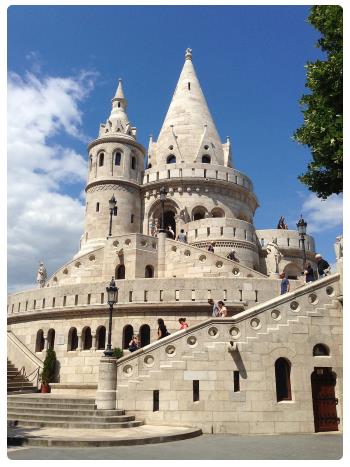|
GUIDE
OF BUDAPEST: 80 FULL INFORMATION PAGES
|
The
city of Budapest is one of the most brilliant gems of the
Danube,
a city that between the highs and lows of a millenarian history, full of
legendary but also dramatic moments, has proved to be a perfect "bridge"
between the East and West of Europe. This aspect has been confirmed for
centuries by the close ties with Austria and Vienna in
particular, since the time of the Habsburg Empire, which had its second
capital here. |
|
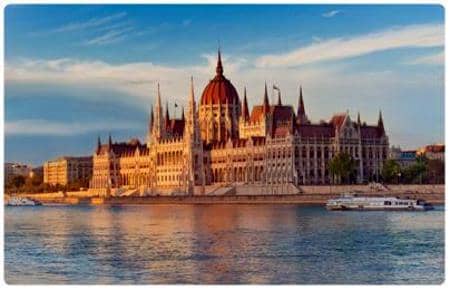 This can be seen in the Danube itself, a guide, a giant
umbilical cord that ideally links Hungary to Europe and
the horizons beyond the borders of the Black Sea. This is
recalled by the attempts of rebellion over the centuries, by
those who were considered "invader"; like the last, in 1956,
that exploded in the period of Soviet control. You can
finally understand this by pausing to admire the World
Heritage sites of the city. Budapest is a unique, capital
and true representative of its nation. Writing a guide to a city
like this is not easy, but we will try. This can be seen in the Danube itself, a guide, a giant
umbilical cord that ideally links Hungary to Europe and
the horizons beyond the borders of the Black Sea. This is
recalled by the attempts of rebellion over the centuries, by
those who were considered "invader"; like the last, in 1956,
that exploded in the period of Soviet control. You can
finally understand this by pausing to admire the World
Heritage sites of the city. Budapest is a unique, capital
and true representative of its nation. Writing a guide to a city
like this is not easy, but we will try.
 Geography,
history and art have contributed to create a place
that fascinates and at the same time amazes. The current
Hungarian capital was only created in 1873, combining the former
separate cities of Buda, Obuda and Pest.
The first two were on the western bank of the Danube, the third
on the eastern bank. Budapest is home to 20% of the Hungarian
population and accounts for more than 60% of the economic
activities of industry and the service sector. All the
revolutionary movements that have shaken the country began here,
in Budapest is also concentrated the artistic and cultural
life of the nation. Today there are almost two million
inhabitants, divided into the 23 districts that make up the
urban area (6 in Buda, 16 in Pest and 1 in the middle, in the
island of Csepel, the largest island of the Danube). Geography,
history and art have contributed to create a place
that fascinates and at the same time amazes. The current
Hungarian capital was only created in 1873, combining the former
separate cities of Buda, Obuda and Pest.
The first two were on the western bank of the Danube, the third
on the eastern bank. Budapest is home to 20% of the Hungarian
population and accounts for more than 60% of the economic
activities of industry and the service sector. All the
revolutionary movements that have shaken the country began here,
in Budapest is also concentrated the artistic and cultural
life of the nation. Today there are almost two million
inhabitants, divided into the 23 districts that make up the
urban area (6 in Buda, 16 in Pest and 1 in the middle, in the
island of Csepel, the largest island of the Danube).
Back up
A language that seems indecipherable
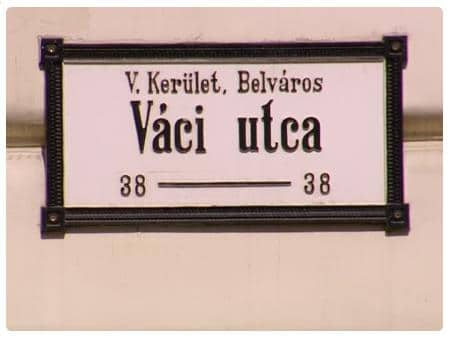 Tourists
who come to Budapest or the rest of Hungary are faced with almost indecipherable
writings. It penetrates into vowels and consonants with a sweet and mysterious
sound. The country, also from the point of view of language, is a strange
splinter stuck in the heart of Europe. A theologian, Jànos Sajnovics,
demonstrated that Hungarian was a relative of the Lapland. Linguists have always
tried to understand where exactly you came from, from the Russian steppes, from
the banks of some rivers far away, from the inaccurate East. Those who study the
origins of Indo-European origin have ancient alphabets at their disposal. The
uralists, on the other hand, a few magic inscriptions since the 12th century,
and a "averse" against lightning strikes engraved in Karelian on birch
wood. Over time, the Italian public has discovered Hungarian-speaking writers
such as Màrai, Esterhàzy, Kosztolànyi, Ottlik,
Krùdy. Late, it was also the universal recognition of the Nobel Prize, to
Imre Kertész. Hidden in the rest of the way by a distant language, unknown
to Indo-Europeans, Hungary has cultivated secluded but very beautiful literature
for centuries. Able to enter into the mirages of humanity, into its fragility.
Because, despite that, he has always found himself in the turbulent centre of
the world. Tourists
who come to Budapest or the rest of Hungary are faced with almost indecipherable
writings. It penetrates into vowels and consonants with a sweet and mysterious
sound. The country, also from the point of view of language, is a strange
splinter stuck in the heart of Europe. A theologian, Jànos Sajnovics,
demonstrated that Hungarian was a relative of the Lapland. Linguists have always
tried to understand where exactly you came from, from the Russian steppes, from
the banks of some rivers far away, from the inaccurate East. Those who study the
origins of Indo-European origin have ancient alphabets at their disposal. The
uralists, on the other hand, a few magic inscriptions since the 12th century,
and a "averse" against lightning strikes engraved in Karelian on birch
wood. Over time, the Italian public has discovered Hungarian-speaking writers
such as Màrai, Esterhàzy, Kosztolànyi, Ottlik,
Krùdy. Late, it was also the universal recognition of the Nobel Prize, to
Imre Kertész. Hidden in the rest of the way by a distant language, unknown
to Indo-Europeans, Hungary has cultivated secluded but very beautiful literature
for centuries. Able to enter into the mirages of humanity, into its fragility.
Because, despite that, he has always found himself in the turbulent centre of
the world.
Back up
An ancient history
|
|
The origins of Budapest are ancient, the
first settlement is attributed to a Celtic strain
tribe that dates back to the 1st century BC:
Ak-Ink (that is, abundant water, significant in
testifying to the presence of numerous springs and
streams). With the advent of the Romans and the
forced migration of the Celtic populations to the
north, the small settlement was transformed into a
military legion.
|
The settlement was called Aquincum, which in 198 AD. acquired
the status of a colony, where it seems that there
was a bigger theatre of the Colosseum that
the "barbarians" destroyed.
The city has always been the hinge between two worlds that have
clashed here for centuries. Romans, steppe peoples, Mongols,
Christians, Turks, Germans and Magyars, liberists and communists.
Here the oppressed become oppressors; martyrs, torturers;
victors defeated; freeing occupations; revolutions against
revolution; farcical tragedies. A Hungarian would tell you that.
The grand parliament on the banks of the Danube, the
result of an enormous self-esteem and ambition, was built in
1902, with 700 rooms, 18 courtyards, steeples everywhere,
stained-glass windows, frescoes, marble, gold decorations, and
soon became one of the largest in the world. After sixteen years,
a palace of this kind seemed disproportionate for just ten
million inhabitants. But by now they had built it and today we
can admire it in all its splendour.
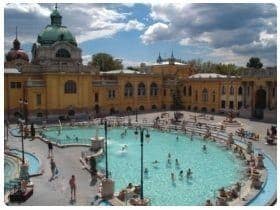 The
influence of ancient Rome can still be seen today,
especially with the most characteristic legacy of the Hungarian
capital, the thermal baths of Budapest. The city is also
often called the "Paris of the East", comparing it in
beauty to the "Ville Lumière", as one of the most
beautiful capitals in the world. The city life is lively,
fun and cosmopolitan, characterized by the running
of the Danube, eternal presence, which divides the city into two,
separating the historic Buda hill from the commercial and
chaotic Pest. The two parts are connected by several
bridges, including the famous
Chain Bridge, which we will
discuss later in more detail. The
influence of ancient Rome can still be seen today,
especially with the most characteristic legacy of the Hungarian
capital, the thermal baths of Budapest. The city is also
often called the "Paris of the East", comparing it in
beauty to the "Ville Lumière", as one of the most
beautiful capitals in the world. The city life is lively,
fun and cosmopolitan, characterized by the running
of the Danube, eternal presence, which divides the city into two,
separating the historic Buda hill from the commercial and
chaotic Pest. The two parts are connected by several
bridges, including the famous
Chain Bridge, which we will
discuss later in more detail.
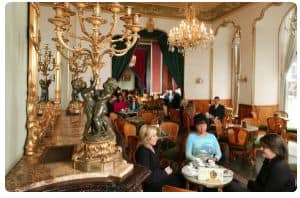 The
Hungarian capital is neither too big nor too small. Its
right size makes it a pleasant place to explore. Moving
around in Budapest is certainly not a problem, thanks also
to the transport system of the BKV (Budapest Kozlekedesi
Vallalat), the company that manages the bus, metro
and tram network. If you prefer to use the taxi
service, we recommend that you plan your itinerary and fare with
the taxi driver before you leave, and also remember to have the
receipt given in case of complaints or possible loss of your
objects or documents inside the car. The
Hungarian capital is neither too big nor too small. Its
right size makes it a pleasant place to explore. Moving
around in Budapest is certainly not a problem, thanks also
to the transport system of the BKV (Budapest Kozlekedesi
Vallalat), the company that manages the bus, metro
and tram network. If you prefer to use the taxi
service, we recommend that you plan your itinerary and fare with
the taxi driver before you leave, and also remember to have the
receipt given in case of complaints or possible loss of your
objects or documents inside the car.
Back up
The districts of Budapest

The districts of the city are identified through Roman numerals.
An address resembles something like H-1121 Budapest XII: the postcode is
indicated first, followed by the district number, street name, house number and
floor number. The same code is made up of 4 numbers, of which the 2 in the
middle show the district. In the example, H-1121 is for the twelfth district (XII).
The hilly area of Budai Vár Castle belongs to the first district, in
the part of Buda. Today it is difficult to imagine the damage suffered by
the Royal Palace and the medieval and baroque residences during the
Second World War, where we remember, 85,000 citizens of Budapest of
Jewish religion lost their lives, among others.
 Baroque
style avenues of the Fo utca and Batthyany ter, where we find
the most spectacular view of the city. The center is called Belváros
and is part of the fifth district of Pest, in its interior we also find the
avenue Kiskörút (literally Small Boulevard). Along its axis is
located the characteristic Vasarcsarnok market (see Budapest's Central
Market), at one end, and the Vaci utca, the shopping area. Baroque
style avenues of the Fo utca and Batthyany ter, where we find
the most spectacular view of the city. The center is called Belváros
and is part of the fifth district of Pest, in its interior we also find the
avenue Kiskörút (literally Small Boulevard). Along its axis is
located the characteristic Vasarcsarnok market (see Budapest's Central
Market), at one end, and the Vaci utca, the shopping area.
The administrative section of Budapest, Lipotvaros, extends between
Bajcsy-Zsilinsky and the Danube and includes the majestic
Országháze Parliament Palace, which also houses the Holy Crown of
Hungary (also known as the Crown of St. Stephen). The sixth
district, constitutes the cultural center of the city, within it is located
the Andrássy Út, the most beautiful boulevard of Budapest. Very
interesting and full of life and cultural activities is the VII distetto,
Erzsébetváros (City of Elisabeth), the most populous district of the
city, which is located between the avenues Andrássy and Rakóczi út, whose
inner part is the historic Jewish district of Pest, with inside the Great
Synagogue, the largest synagogue existing in Europe, and the largest in
Europe.
Back up
A Muslim mausoleum in the
centre of Europe
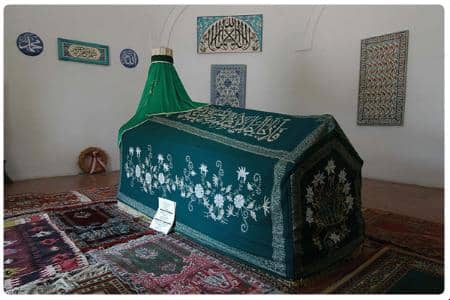 A
very particular and interesting monument to Budapest is located in the so-called
Rose Hill, the Mausoleum of Gul Babà (the name means "father of roses"),
an implacable warrior who led a devout life, who died in 1541. One of the few
remains of the great Ottoman invasion in Hungarian land, one of the last, very
rare symbols of the Muslim conquest in Europe. The tomb of Sultan Gul Babà is
located at number 14 Mecset Utca, and is accessed after climbing a staircase in
one of the most beautiful and ancient streets of Buda. A
very particular and interesting monument to Budapest is located in the so-called
Rose Hill, the Mausoleum of Gul Babà (the name means "father of roses"),
an implacable warrior who led a devout life, who died in 1541. One of the few
remains of the great Ottoman invasion in Hungarian land, one of the last, very
rare symbols of the Muslim conquest in Europe. The tomb of Sultan Gul Babà is
located at number 14 Mecset Utca, and is accessed after climbing a staircase in
one of the most beautiful and ancient streets of Buda.
He was a legendary and mysterious character. The mausoleum is a sacred place for
Muslims: for centuries the Muslim faithful have been on pilgrimage here in the
heart of Europe. Gul Babà died on September 2,1541, during a ceremony of
thanksgiving in the Basilica of San Mattia, then sumptuous mosque: he
fell suddenly, in general amazement. The Turks had conquered Buda only nine days
earlier (they were to be driven out of Europe in 1686). The warrior was
consecrated patron saint of the city by Suleiman II the Great, who had
the mausoleum built for him. Around, many roses, to remember the wonderful
gardens of the East.
Back up
Many sights to see
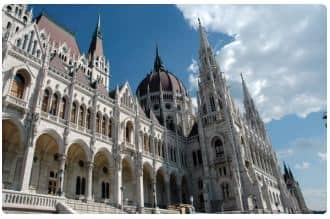 The
tourist attractions in Budapest are numerous, among the main
monuments are not to be missed the Royal Palace (Királyi Palota), in
the complex of Buda Castle, where there are also the National
Gallery (Nemzeti Galéria). Nearby there are also the Fishermen's
Bastion, the Church of Matthias (Mátyás templom), the museums of
the Hill (military, music, Jewish, among others), all the bridges of the
Danube and in particular the Chain Bridge (Széchenyi Lánchíd),
the island of Margitsziget and its park, the ruins of the
ancient Roman city of Aquincum in the museum of the same name.
Today's Budapest is by far the richest and most cosmopolitan city in Hungary
and is increasingly popular with tourists. In 1987 he was listed in the
UNESCO World Heritage List for the cultural and architectural
significance of the banks of the Danube, for the Buda Castle district
and the beautiful Andrássy ut boulevard. The
tourist attractions in Budapest are numerous, among the main
monuments are not to be missed the Royal Palace (Királyi Palota), in
the complex of Buda Castle, where there are also the National
Gallery (Nemzeti Galéria). Nearby there are also the Fishermen's
Bastion, the Church of Matthias (Mátyás templom), the museums of
the Hill (military, music, Jewish, among others), all the bridges of the
Danube and in particular the Chain Bridge (Széchenyi Lánchíd),
the island of Margitsziget and its park, the ruins of the
ancient Roman city of Aquincum in the museum of the same name.
Today's Budapest is by far the richest and most cosmopolitan city in Hungary
and is increasingly popular with tourists. In 1987 he was listed in the
UNESCO World Heritage List for the cultural and architectural
significance of the banks of the Danube, for the Buda Castle district
and the beautiful Andrássy ut boulevard.
 So
many places to see as well as many good restaurants,
which are almost an aperitif to a varied nightlife. After
an intense day of visits, the evening is dedicated to the
flavors of local gastronomy, with the possibility to
spend little money despite the luxury restaurants. During the
day you can visit interesting museums and historic churches,
(among them the beautiful St. Stephen's Basilica) and between
them take a break in one of the many bohemian-style cafes.
Water and spa. The city is full of it, 70 million litres of hot
thermal waters flow out every day from 118 natural springs, many
of which are outdoors, in a square or corner of a tree-lined
avenue. In the evening, if you prefer, you can opt, why not, for
a show in the Budapest Opera House, one of the most
important in the world, and then finish the evening in one of
the discos of the city. So
many places to see as well as many good restaurants,
which are almost an aperitif to a varied nightlife. After
an intense day of visits, the evening is dedicated to the
flavors of local gastronomy, with the possibility to
spend little money despite the luxury restaurants. During the
day you can visit interesting museums and historic churches,
(among them the beautiful St. Stephen's Basilica) and between
them take a break in one of the many bohemian-style cafes.
Water and spa. The city is full of it, 70 million litres of hot
thermal waters flow out every day from 118 natural springs, many
of which are outdoors, in a square or corner of a tree-lined
avenue. In the evening, if you prefer, you can opt, why not, for
a show in the Budapest Opera House, one of the most
important in the world, and then finish the evening in one of
the discos of the city.
Back up
A city born from a
bridge
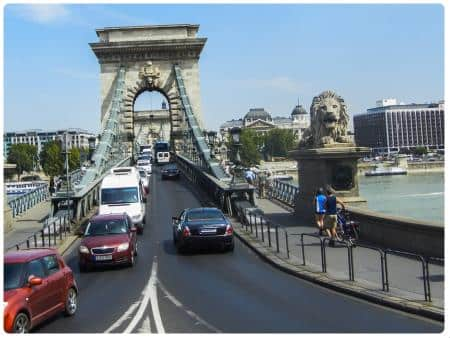 If
we really have to dwell on one of Budapest's many attractions, it is perhaps
right to do so, not only for the palaces and churches, but also for a bridge.
Someone claims that the city is the daughter of the Chain Bridge, built
thanks to the skills of a noble man, Count Széchenyi, who financed its
construction, and designed by an English engineer: William Tierney Clark. In
1830 Budapest, then the second city of the Austrian Empire, had no fixed bridge
over the Danube. A bridge of boats, which was dismantled in winter to avoid the
damage caused by the icy river, allowed only uncomfortable connections between
the three then still divided cities of Buda, Pest and Obuda. But this story is
long and we refer you to the page on the
Chain Bridge for
further information. If
we really have to dwell on one of Budapest's many attractions, it is perhaps
right to do so, not only for the palaces and churches, but also for a bridge.
Someone claims that the city is the daughter of the Chain Bridge, built
thanks to the skills of a noble man, Count Széchenyi, who financed its
construction, and designed by an English engineer: William Tierney Clark. In
1830 Budapest, then the second city of the Austrian Empire, had no fixed bridge
over the Danube. A bridge of boats, which was dismantled in winter to avoid the
damage caused by the icy river, allowed only uncomfortable connections between
the three then still divided cities of Buda, Pest and Obuda. But this story is
long and we refer you to the page on the
Chain Bridge for
further information.
Back up
Sisi and Budapest
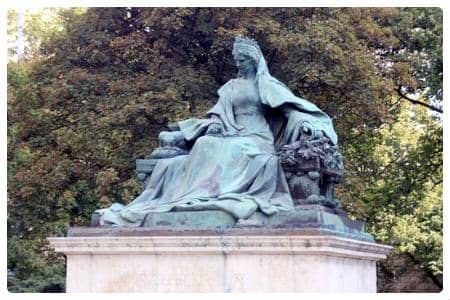 Empress
Elisabeth of Bavaria, now universally known as Sisi, after the
hugely successful films of the 1950s, became an icon of Vienna, like the
Sachertorte,
The Blue Danub of
Strauss, the
Secession and the
smokeful intellectual cafes. But Budapest could also boast the same icon on
Sisi in many ways. Elizabeth was very much loved by Hungarians. When in
February 1867 Francis Joseph granted the Constitution to the Magyar
people, it was known that the greatest work of persuasion had made her, Sisi.
Hungary gave her the Godollo Castle, a wonder, amidst forests and
horse riding grounds made for her, who lived there many times satisfying her
passion for hunting and horses, Hungarian horses, bred in the puszta, the
great Hungarian plain, wild means, fine as Arab horses, nervous and vibrant
as English horses. Empress
Elisabeth of Bavaria, now universally known as Sisi, after the
hugely successful films of the 1950s, became an icon of Vienna, like the
Sachertorte,
The Blue Danub of
Strauss, the
Secession and the
smokeful intellectual cafes. But Budapest could also boast the same icon on
Sisi in many ways. Elizabeth was very much loved by Hungarians. When in
February 1867 Francis Joseph granted the Constitution to the Magyar
people, it was known that the greatest work of persuasion had made her, Sisi.
Hungary gave her the Godollo Castle, a wonder, amidst forests and
horse riding grounds made for her, who lived there many times satisfying her
passion for hunting and horses, Hungarian horses, bred in the puszta, the
great Hungarian plain, wild means, fine as Arab horses, nervous and vibrant
as English horses.
Despite his horror at the official court ceremonies, Sisi was subjected to
the coronation party in Budapest, Queen of Hungary. She felt loved by the
Hungarian people and she loved him. He perfected in the Hungarian language,
read Hungarian poets, even received opposition ministers. "You know -
he said - " I do not mean politics. But the best policy - one of his
ministers replied - is to conquer the heart of a country and your majesty
has been perfectly successful".
Back up
The Hungarian Revolution of 1956
Parlando
di Budapest, delle sue strade, dei suoi monumenti e delle sue tante
bellezze, non possiamo fare a meno di parlare brevemente di quella che passò
alla storia come Rivoluzione Ungherese del 1956, un sogno di rivalsa
democratica, che in qualche modo ispirò il mondo intero e che venne, tra lo
sgomento internazionale, soffocato nel sangue dall'intervento delle truppe
sovietiche, nelle stesse strade che vi accingete a visitare. Poiché è sempre
meglio ricordare, per non dimenticare, vi accenneremo quei momenti. Anche in
questo caso vi rimandiamo per un approfondimento alla pagina sulla
Rivoluzione Ungherese del 1956.
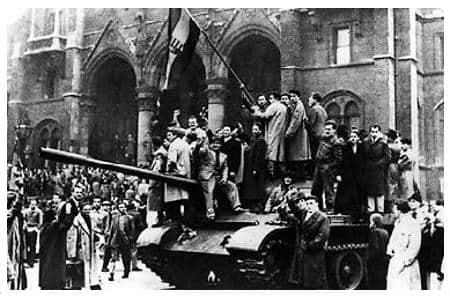 Speaking
about Budapest, its streets, its monuments and its many beauties, we cannot help
but briefly talk about what went down in history as the Hungarian Revolution
of 1956, a dream of democratic revenge, which in some way inspired the whole
world and which came, amidst international dismay, suffocated in blood by the
intervention of Soviet troops, in the same streets that you are about to visit.
Since it is always better to remember, so as not to forget, we will mention
those moments. Also in this case we refer you for further information on the
page on the
Hungarian Revolution of 1956. Speaking
about Budapest, its streets, its monuments and its many beauties, we cannot help
but briefly talk about what went down in history as the Hungarian Revolution
of 1956, a dream of democratic revenge, which in some way inspired the whole
world and which came, amidst international dismay, suffocated in blood by the
intervention of Soviet troops, in the same streets that you are about to visit.
Since it is always better to remember, so as not to forget, we will mention
those moments. Also in this case we refer you for further information on the
page on the
Hungarian Revolution of 1956.
Copyright © Informagiovani-italia. com. Reproduction in whole
or in part, in any form, on any medium and by any means is prohibited
without written permission.
If you liked this guide and would like to help Informagiovani-italia. com
help us spread it.
Where is
it located?
Back up
Ostelli Budapestest
Ostelli
Ungheria
Hotel
a Budapest
Hotel in Ungheria
Carte de Budapest
Karte von Budapest
Mapa Budapest
Map of Budapest
Carte de Hongrie
Karte von Urgan
Mapa
Hungría
Map of Hungary
|
